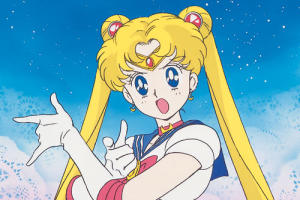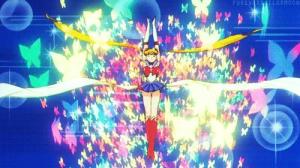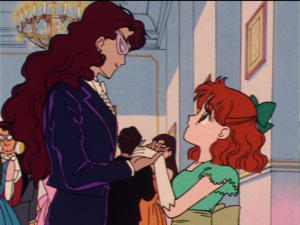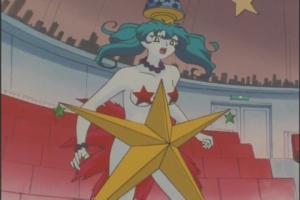Sailor Moon is unquestionably the sparkling, magical queen of the magical girl genre. What Sailor Moon did would redefine the entire genre, as well as introduce an entire generation of young people to manga, anime, and girl power.
A brief history of Sailor Moon: in 1991, a one shot manga called Codename: Sailor V was published in the manga magazine RunRun. Written and drawn by a young woman named Naoko Takeuchi, it became wildly popular. Toei Animation approached Takeuchi to make an anime from Codename: Sailor V but she instead proposed a show about a team of girl warriors. Sailor Moon was born out of this, and the anime and manga would be produced almost concurrently over the next 6 years. Important to note: for simplicity’s sake, I’ll be referring to Sailor Moon as a show, though I am not specifically talking about the anime. I’ll also be referring to characters by their Japanese names for the same reason.

Overly complicating things is unforgivable! I’ll punish you!
There have been many, many adaptations of the original Sailor Moon manga: two animes, three movies, a live action show, multiple musicals, video games and countless other merchandising items. It would take an entire series of articles for me to break down each adaptation, but I’ll mostly be discussing the original manga, and the original 1992 anime. I highly encourage any fans of Sailor Moon who haven’t watched the live action show, Pretty Guardian Sailor Moon, to do so. It had a budget of about 10 dollars, but its heart is in the right place and it does some really interesting things with the source material. Plus at one point Usagi wears a shirt that says “Burger Lovers” and you don’t get much more Sailor Moon than that. Conversely, I don’t particularly recommend Sailor Moon Crystal, and if you want to know more about why you should check out Christina Ladd’s recaps of the show. At its core, it is a show that does not live up to it’s own theme song.
Now if you don’t know, Sailor Moon is about a 14 year old girl named Usagi Tsukino, who meets a black cat named Luna and finds out that she is a pretty guardian of love and justice. The manga and show follow her and her Sailor Senshi friends throughout about 2 years of their teenage lives, saving the world from a number of various disasters and apocalypses. Sailor Moon is notable for being one of the first shows to use the Super Sentai format (a team of heroes) for magical girls. Previous magical girl shows had typically focused on one lead character, and while Sailor Moon certainly revolves around Usagi, she is by no means the sole senshi. I mentioned in my previous article that Sailor Moon gave its female readers the opportunity to have a range of characters to identify with, rather than the token female character. Shy girls could identify with Ami as opposed to the outgoing Usagi, or vice versa. That range of characters ended up being crucial to solidifying Sailor Moon in a lot of young people’s minds, because they could connect on a level they perhaps could not before. Even adults now could probably tell you which Sailor Senshi they “were” as a kid. Sailor Moon‘s is completely missing any people of colour, which is a bummer, but is notable for having a relatively high level of representation for LBGT characters, especially for the early ’90s. There are two canonical gay couples: Zoicite/Kunzite and Sailor Uranus/Sailor Neptune. Famously, Sailor Neptune and Sailor Uranus are a gay couple who were turned into “cousins” for the English adaptation. A fourth season villain named Fish Eye is male, but dresses as a woman when he feels like it and is often considered by fans to be transgender. And the Sailor Starlights from the fifth season are men, but turn into women when they transform. While I am a straight, cis woman I admire the show greatly for adding LGBT representation and giving men and women of all temperaments, gender identities, and sexualities a superhero who was like them.

“Cousins”
Besides providing a level of representation not seen before in the magical girl genre, Sailor Moon also introduced its audience to something (particularly Western audiences) had not seen before: being a badass warrior who could also be pretty and frilly and feminine. Sailor Moon is a princess, but she can also vaporize enemies by throwing her tiara at them. The Senshi wear cute outfits, transform with sparkly pens, but also chuck lightning and fire with their hands. They are pretty guardians of love and justice, and they will punish you.
I can’t overstate how much I unabashedly love Sailor Moon, to this day. It is goofy yet heartfelt, empowering and humorous, full of magic but grounded in real relationships and situations. Over the five seasons the characters grow and change, becoming powerful young women to rival their superhero alter egos. Usagi in particular grows up a lot, starting as a clumsy and lazy crybaby and growing to be a confident and self aware heroine. Usagi’s growth is not just important because she is the main character, but because at our core we are Usagi. At fourteen I was not equipped to save the world and neither was she, she even often rejects the role thrust upon her. But over time Usagi learns that she can’t turn away from her destiny, any more than I could turn away from the (admittedly less perilous) changes in my life. That transformation, not just as a magical girl warrior, but as a person is one of the most important any character or person can go through.

Now if only puberty came with as many sparkles.
Now that I’ve waxed poetic about my love for the show, I’m going to say a few things about the flip side: what I don’t like about it. Sailor Moon contains a really interesting dichotomy about female versus male gaze, which can be seen in the manga compared to the original anime. Series creator Naoko Takeuchi openly said that while the manga was written by women for women, the anime’s staff were almost completely male. I can’t prove specifically that it’s the cause but there are definitely really interesting instances where the male gaze creeps into the anime. The role of Mamoru/Tuxedo Mask is quite different for example. Takeuchi wrote Mamoru as her vision of the ultimate supportive boyfriend, he is Usagi’s greatest cheerleader. Though their relationship is often a part of the plot, it serves to strengthen it. Whereas in the anime, Mamoru takes much more of a protector role with Usagi, even to the point of breaking up with her to “protect” her when he believes she’s in danger, rather than talking to her and working together. Manga Mamoru respects Usagi’s strength and opinion, whereas anime Mamoru often makes decisions for her.
The other big Mamoru based difference between the manga and anime is the ages. In all versions of the show, Usagi is fourteen years old. Just let that sink in for a second, fourteen years old, an eighth grader, barely more than is a child. Now in the manga, Mamoru is seventeen years old, a high school student. But anime Mamoru is twenty three goddamn years old and in college. Again, let that sink in. A twenty three year old man dating a fourteen year old kid. That’s pretty messed up, and it only appears in the anime. Now I’m not saying that the men on the anime all want to secretly bone fourteen year old girls, but it’s quite telling that nobody ever seemed to say “Hey guys, this is fucking creepy.” And this is not the only incredibly questionable relationship in the show, though what I’m about to describe is hardly a relationship. In the first season, Usagi’s best friend Naru falls for an enemy general named Nephrite, who is disguised as a human. Naru is also fourteen, and while Nephrite’s age is never revealed he is portrayed as an adult man. And on top of that, he uses Naru’s infatuation with him to emotionally manipulate her into helping him fight Sailor Moon. In the end, Nephrite supposedly redeems himself before his death by saving Naru from a monster, basically affirming the terrible cliche of “If you love an abuser hard enough, you can fix them.” It is a Grade A fucked up abusive and pedophilic relationship in the middle of a kids show. And honestly the thing that disappoints me most about it, is that it would have been a great chance to show how abusive relationships work, but that side of the coin never comes.

Kids, no matter how beautiful his hair is, he’s still a pedophile.
The last bit of male gaze based weirdness in the show versus manga is the treatment of sexuality. For the most part it’s not particularly overt in either case. But again, the manga treats Usagi and Mamoru as much more equal partners in their relationship. When they do (probably) have sex in the second arc, it’s clearly something they both want out of love. And Usagi is not passive in her sexuality, there are other instances where she is not afraid to ask Mamoru for sex. Now in the anime, there’s basically no sex at any point, though there are some references mostly thrown in for comedic value. Sexuality is addressed in a more abstract, and somewhat creepy way. For example, the Senshi are almost all portrayed as innocent, virginal figures, despite the fact that for Usagi sex is a part of her relationship in the manga. But many of the monsters of the week are portrayed as sexed up, buxom, adult women despite the fact that there’s no reason for them to be portrayed that way. It’s a not so subtle nod towards purity and innocence winning out against overt female sexuality, which is kind of a bummer.

I can’t even with this one.
Now keep in mind, this never stopped the animators from throwing in inexplicable panty shots of our fourteen year old heroines. The most egregious example has to be in the episode where we find out about Sailor Venus’s past, and she has a moment to herself where she mentally gives up on her past love. It’s a big character shift for her, and yet for some reason as the camera pans out to show her against a sunset, the wind whips her skirt up to show her underwear. There’s nothing in the scene that requires her underwear to be showing, and in fact it undercuts the emotional moment of the scene for a bit of fanservice.
Okay, so maybe that came off as a little ranty and I applaud you for sticking with me here. The original anime is almost 25 years old now, so my personal misgivings are not exactly an earth shattering realization to anybody. The part of me that made me go to art school can’t let a conversation about female versus male gaze pass by. And all questionable things aside, the amount of good the 92 anime did in terms of representation and empowerment vastly outweigh the nagging weirdness. Sailor Moon did a lot of good for me in my life, both as a child and now as an adult. As a girl it taught me that even though you got emotional and didn’t like fighting you could be a superhero. As an adult it reminds me of the power of friendship, love and badass women.

Thanks for reading the very first installment of Moon Girls! Next month I’ll be covering Glitter Force, which is available on Netflix and if you’d like to watch along I highly encourage it! Special shout out to my own personal gang of Sailor Senshi on the Random Encounters feed, as well as Sailor Business, a wonderful discussion podcast about the ‘92 anime. A lot of the things I talked about in this article are also discussed with the relevant episodes on that show. Thanks again for reading and I’ll see you next month with Glitter Force!
Moon Girls is a monthly column for GeeklyInc. where Steph Kingston discusses Magical Girl anime and TV shows. Get ahold of Steph on Twitter @StephOKingston or stephanieokingston@gmail.com
Amazing banner art by Kym Stonick, you can find her @kymcattys or http://kymstone.tumblr.com/

The main characters of Sailor Moon are literally Japanese school girls that all have Japanese names, so I’m confused how Asians are suddenly not poc? It’s either a really white thing to assume, or in an attempt to be “woke” the author has erased the identity of a whole group of ppl. Other than that this
was a great think piece.